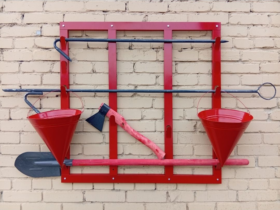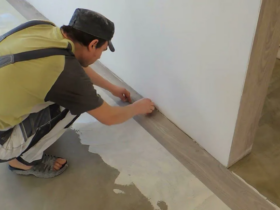In the event that you often want to change the interior of your house, you need to choose wallpaper for painting non -woven. The fact is that you can repaint these coatings up to 8-10 times. Thus, you can create a new design every time without changing the material.
What are the disadvantages and pros?
Video review — non -woven wallpaper and their features
Wallpaper wallpaper — multi -layer material that is made of cellulose and some additives. One of the main advantages of this coating is a good thickness. Therefore, during gluing on the canvas, bubbles and folds usually do not form. These canvases also perfectly reinforce small cracks. That is, small flaws can not be putty, their wallpaper will be closed. And you can apply them to any type of base, whether it be concrete, drywall, brick and so on. In addition, they have many other advantages:
Provide proper steam — and breathability, that is, allow the surface to «breathe».
Not afraid of ultraviolet rays, do not burn out over time.
Are environmentally friendly material, therefore they are often used in children’s and sleeping rooms.
Repainted up to 8-10 times. You can change the interior when you want.
Are elastic and do not crack from sharp temperature differences.
The life of these coatings significantly exceeds the service life of paper wallpaper.
Disadvantages can be distinguished mainly during laying. Firstly, the non-woven canvases are quite heavy. It is advisable to glue them with a partner. Secondly, during the application of paintings that go out on the sides, the glue should immediately remove. Since if he gets on the front side, it will be difficult to wipe it later.
How to choose material, paint and glue?
The video presents tips on gluing non -woven wallpaper
Before buying these wallpaper, you should know some nuances about them. First, decide on the size. They are available in standard (0.53) and meter rolls. Then it is important for you to determine whether you will color the coating or not? In the event that you do not want to color, but choose light shades, you will have to think in the future about leveling the color of the surface. The fact is that the non -woven itself is a transparent material, unlike paper. And light wallpapers often shine through. If the coloring is supposed, then it is worth choosing a water -dispersed or water -based composition.
Moreover, it is desirable that a kner is added to it. Before buying, be sure to test the paint. Apply it to a small piece of material. Wait for the moment of drying the paint and see the result. If he suits you, then take this color color. It is also worth knowing that all light wallpapers are important to paint the tone darker. In this case, they will definitely not shine through. Well, the last thing to pay attention to is textured drawings that are small and large. Small patterns make the interior “lighter”, large, on the contrary, “heavy”, but they hide the surface defects.
As for glue, there may be two options. First — indicated on the packaging of wallpaper. For non -woven paintings, its composition is released. He is the best option. In the event that you did not find it in the store or it is supposed to glue several types of canvases, then you can choose a universal glue. The recipe for making glue is also indicated on the package. Usually, a dry composition is poured into the container and diluted with warm water. Then all this is thoroughly mixed to the state until the mixture has a homogeneous consistency (without lumps). Then it should stand for about 15 minutes and after it is again mixed.
How to stick non -woven wallpaper for painting?
So, after the non -woven wallpaper is chosen, paint and glue are selected, proceed to their application. However, it is important to prepare the surface before this. The old coating is removed from the walls, the base is cleaned and aligned. Carry out its primer. Further, when the surface is ready, they start direct gluing. Rolls are deployed on the floor or table, measure the required length and cut off. The length of one canvas should vice in the height of the wall plus 5-6 centimeters. Then cover the base with wallpaper glue. At the same time, a special wide brush or roller is used.
At the next stage, they begin to apply canvases from the corner or window of the room. Glue each strip from top to bottom and thoroughly smooth after. So, gradually apply all the canvases. Below the excess is carefully cut off with a special knife. After a couple of days, when the canvases are dried up, you can start painting the wallpaper. The paint is poured into the tray and the roller is rolled out in it (it is desirable that it be foam rubber). Then, when it is properly saturated with the composition, it is slightly squeezed and vertical movements on the surface of the walls are carried out. Thus gradually finish the entire surface. But it is worth knowing that it is not always possible to paint some places well the first time. Therefore, the procedure can be repeated.
Attention! All of the above work is important to carry out in a building with closed doors and windows in order to avoid the appearance of drafts.













Оставить коммент.